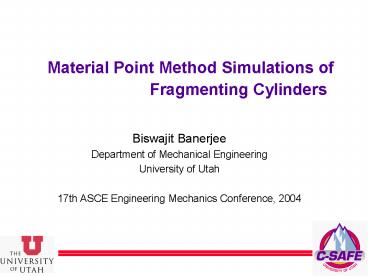Material Point Method Simulations of Fragmenting Cylinders - PowerPoint PPT Presentation
1 / 23
Title:
Material Point Method Simulations of Fragmenting Cylinders
Description:
Department of Mechanical Engineering. University of Utah ... Flow stress : Johnson-Cook, Mechanical Threshold Stress, Steinberg-Cochran-Guinan ... – PowerPoint PPT presentation
Number of Views:199
Avg rating:3.0/5.0
Title: Material Point Method Simulations of Fragmenting Cylinders
1
Material Point Method Simulations of Fragmenting
Cylinders
- Biswajit Banerjee
- Department of Mechanical Engineering
- University of Utah
- 17th ASCE Engineering Mechanics Conference, 2004
2
Outline
- Scenario
- Material Point Method (MPM)
- Approach
- Validation
- Simulations of fragmentation
3
Scenario
4
What happens to the container ?
5
Simulation Requirements
- Fire-container interaction
- Large deformations
- Strain-rate/temperature dependence
- Failure due to void growth/shear bands
6
The Material Point Method (MPM)(Sulsky et
al.,1994)
7
Why MPM ?
Advantages
Disadvantages
- Tightly-coupled fluid-structure interaction.
- No mesh entanglement.
- Convenient contact framework.
- Mesh generation trivial.
- Easily parallelized.
- No tensile instabilities.
- First-order accuracy.
- High particle density for tension dominated
problems. - Computationally more expensive than FEM.
8
Stress update
- Hypoelastic-plastic material
- Corotational formulation (Maudlin
Schiferl,1996) - Semi-implicit (Nemat-Nasser Chung, 1992)
- Stress tensor split into isotropic/deviatoric
- Radial return plasticity
- State dependent elastic moduli, melting
temperature
9
Plasticity modeling
- Isotropic stress using Mie-Gruneisen Equation of
State. - Deviatoric stress
- Flow stress Johnson-Cook, Mechanical Threshold
Stress, Steinberg-Cochran-Guinan - Yield function von Mises, Gurson-Tvergaard-Needl
eman, Rousselier - Temperature rise due to plastic dissipation
- Associated flow rule
10
Damage/Failure modeling
- Damage models
- Void nucleation/growth (strain-based)
- Porosity evolution (strain-based)
- Scalar damage evolution Johnson-Cook/Hancock-MacK
enzie - Failure
- Melt temperature exceeded
- Modified TEPLA model (Addessio and Johnson, 1988)
- Drucker stability postulate
- Loss of hyperbolicity (Acoustic tensor)
11
Fracture Simulation
- Particle mass is removed.
- Particle stress is set to zero.
- Particle converted into a new material that
interacts with the rest of the body via contact.
12
Validation Plasticity Models
635 K 194 m/s
718 K 188 m/s
JC
MTS
SCG
JC
MTS
SCG
655 K 354 m/s
727 K 211 m/s
6061-T6 Aluminum
EFC Copper
13
Validation Mesh dependence
1,200,000 cells
151,000 cells
18,900 cells
OFHC Copper 298 K 177 m/s MTS
11,500 cells
735,000 cells
91,800 cells
6061-T6 Al 655 K 354 m/s JC
14
Validation Penetration/Failure
15
Validation Penetration/Failure
160,000 cells
1,280,000 cells
16
Validation Erosion Algorithm
17
Validation Impact
18
Validation Impact Results
19
Validation 2D Fragmentation
20
Validation 2D Fragmentation
JC (steel), ViscoScram (PBX 9501)
MTS (steel), ViscoScram (PBX 9501)
Gurson-Tvergaard-Needleman yield, Drucker
stability, Acoustic tensor, Gaussian porosity,
fragments match Grady equation, gases with
ICE-CFD code.
21
Simulations 3D Fragmentation
22
Simulation Container in Fire
23
Questions ?































